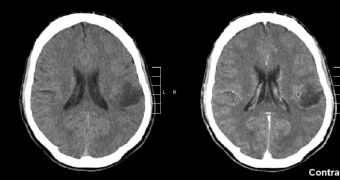For the first time in more than 30 years, scientists were able to cultivate cells from a very dangerous type of brain cancer – called glioma – that most affects children, and is often fatal.
Such an achievement could represent the first ray of hope in this field of research for a very long time. This type of pediatric brain tumor causes enormous suffering for kids, before taking their lives.
The outcome is fatal in all but a very few instances, and so researchers have been keen to devise a course of treatment against it. Unfortunately, despite their best efforts, they failed to do so until now.
A breakthrough was achieved by experts with the School of Medicine at the Stanford University, who were able to cultivate cells from glioma in the tightly-controlled confines of a scientific laboratory.
The full name of the condition is Diffuse Intrinsic Pontine Glioma (DIPG). The Stanford team was able to use the cultivated cells to create an animal model of the condition, which they can now study.
None of this would have been possible without the hard sacrifice the parents of young brain cancer victims made when they gave portions of their children's affected brains to scientists for study.
They did so in hopes that no other parents would have to go through what they did. Experts were able to cultivate DIPG cells only once they had access to the tumors. In living patients, the cancer is located in the brain stem, so biopsies are rarely conducted.
“These donations open up the world in terms of being able to study this tumor, understand the biology behind its growth and develop therapies,” explains Michelle Monje, MD, PhD.
She is an instructor in neurology and neurological sciences at the university, and also the primary author of paper detailing the findings. The work was published on the February 28 online issue of the esteemed journal Proceedings of the National Academy of Sciences.
DIPG “a death sentence for kids. No parent should have to hear that, but doctors can’t study the disease unless somebody makes a donation,” says John Jewett. His son Dylan succumbed to the condition in 2009, at the age of 5.
He and wife Danah were the first parents to give their son's tumor up for study. The Stanford team got the chance to make this breakthrough only thanks to people who followed the example set by them.
Investigators have already discovered molecular signals that could constitute the basis for future anti-DIPG drugs. Research in this field is likely to pick up now, and perhaps other teams could be persuaded to join in the effort as well.
“This work has the potential of moving us a huge step forward, particularly with the identification of a specific pathway important in the biology of the tumor, which could serve as a therapeutic target,” concludes Philip Beachy, PhD.
He holds an appointment as a professor of developmental biology at Staford, and is also the senior author of the PNAS study.

 14 DAY TRIAL //
14 DAY TRIAL //